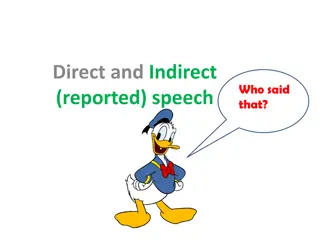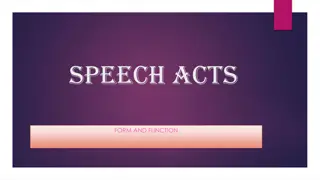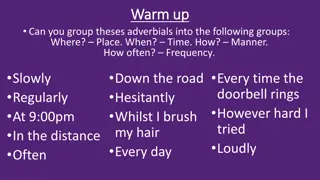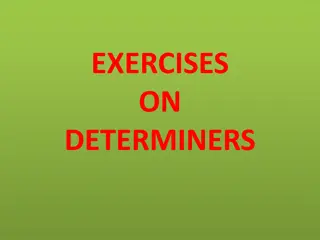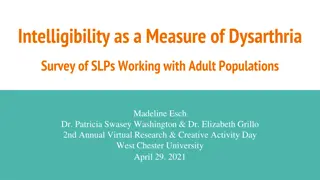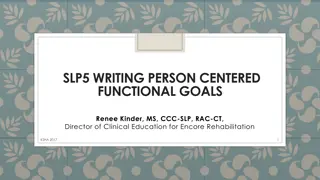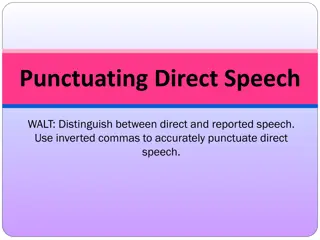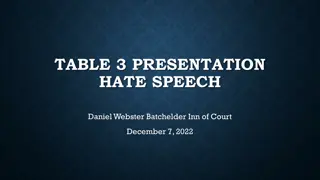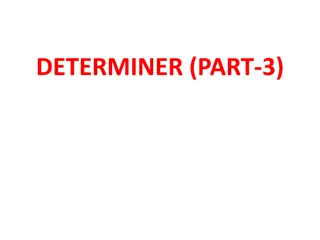Parts of Speech: Determiners and Beyond
Exploring determiners as part of speech, including articles, demonstratives, and possessives. Learn how determiners classify nouns based on different criteria and discover the variations in determiners across languages.
Download Presentation

Please find below an Image/Link to download the presentation.
The content on the website is provided AS IS for your information and personal use only. It may not be sold, licensed, or shared on other websites without obtaining consent from the author.If you encounter any issues during the download, it is possible that the publisher has removed the file from their server.
You are allowed to download the files provided on this website for personal or commercial use, subject to the condition that they are used lawfully. All files are the property of their respective owners.
The content on the website is provided AS IS for your information and personal use only. It may not be sold, licensed, or shared on other websites without obtaining consent from the author.
E N D
Presentation Transcript
Language Awareness for Key Stage 3 5: Parts of Speech Part III 1
Roadmap So far, we have looked at several parts of speech, including nouns, verbs, pronouns, adjectives, and adverbs These parts of speech often refer to objects and activities in the real world (e.g. trees, running) In addition to these, there also several other parts of speech, which are sometimes called function words These are geared toward indicating relationships among other parts of a sentence Today we will look at determiners, prepositions, conjunctions, auxiliaries, and interjections 2
Determiners There are several different types of determiner, including Articles (a, the ) Demonstratives (this, that ) Possessives (my, your ) 3
Determiners Why do we say that all these different words belong to a single category? 4
Determiners Why do we say that all these different words belong to a single category? Because it is only possible to use one of them at a time 1. a my friend 2. your this house If we want to express these ideas, we have to find a different way of saying them 3. a friend of mine 4. this house of yours 5
Determiners Determiners provide different ways of classifying nouns: New/old information 5. Do you have a cat? Where is the cat? Location (near/far) 6. This box is here, but that box is over there Person 7. My coat is blue; your coat is black 6
Determiners Determiners can vary from language to language Some of the greatest variation is in the articles that different languages have 7
Determiners English has both a definite and an indefinite article 8. I saw a cat 9. Where is the cat? Some languages, like Irish, have only a definite article 10.Chonaic m cat 11.C bhfuil an cat? Other languages, like Latin, have no articles at all 12.Vidi felem 13.Ubi est felis? 8
Determiners Articles in English and Irish are separate words 14.Where is the cat? 15.C bhfuil an cat? In some languages, such as Swedish, articles are attached to the noun 16.Var r katten? This -en is the definite article 9
Determiners Most languages have demonstratives, but languages can differ in how these work In English, this and that are single words 17.This man 18.That woman In other languages, like French and Irish, the same meaning may be expressed by combining separate words 19.Cet homme-ci 21. An fear seo 20.Ce femme-l 22. An bhean sin 10
Activity Some of you may know other languages besides the ones mentioned here Do any of these languages have determiners that we haven t discussed? Do any of these languages have fewer determiners than in English? If so, what do these languages do instead? 11
Prepositions Prepositions can express a relationship between a noun and another noun, or between a noun and a verb 23.The letter from John fell under the table In this example, the preposition from expresses the relationship between the noun letter and the noun John The preposition under expresses the relationship between the verb fell and the noun table 12
Prepositions Many prepositions refer to relationships in space (in, over, under) 24.The plane flew over the mountains Prepositions can also refer to relationships in time (before, after) 25.We left before noon Some prepositions describe more abstract relationships (despite, except) 26.They stayed despite the weather 13
Prepositions Most prepositions can express more than one type of relationship 27.She said it in class (space) 28.She said it in the morning (time) 29.She said it in perfect seriousness (manner abstract) 14
Prepositions These words are called prepositions because they are placed before the noun In some languages, such as Japanese, words with the same meaning are placed after the noun 30.nihon ni in Japan When they are placed after the noun, these words are called postpositions 15
Activity There are some words that can function either as adverbs or as prepositions. For example, down in climb down is an adverb, because it modifies the verb on its own, but down in climb down the ladder is a preposition, because it relates a noun to the verb. 16
Activity Read the sample text in your handout Underline all the adverbs Circle all the prepositions Be sure to include words with just a single function, like quickly 17
Solution 18
Solution You can see the adverbs and prepositions marked below: So the boat was left to drift down the stream as it would, till it glided gently in among the waving rushes. And then the little sleeves were carefully rolled up, and the little arms were plunged in elbow-deep to get the rushes a good long way down before breaking them off and for a while Alice forgot all about the Sheep and the knitting, as she bent over the side of the boat, with just the ends of her tangled hair dipping into the water 19
Conjunctions Conjunctions are words that combine separate, independent sentences into a single, larger sentence 31.The sky is blue 32.The grass is green 33.The sky is blue and the grass is green 20
Conjunctions Some conjunctions (e.g. and, or) are coordinating conjunctions They simply link sentences without saying that there is any relation between them 34.The sky is blue and there are no clouds 35.The sky is blue and the grass is green 21
Conjunctions Other conjunctions (e.g. because, while) are subordinating conjunctions They make the meaning of one sentence dependent on the other in some way 36.The sky is blue because there are no clouds 37.The sky is blue because the grass is green 22
Conjunctions One type of word used to combine sentences is sometimes called a complementizer Complementizers allow what was originally a separate sentence to become the complement of a noun or a verb 38.There is a possibility that it might rain 39.John asked whether you were coming 23
Auxiliaries Auxiliaries are another type of function word Auxiliaries are special verbs used to modify the meaning of other verbs 24
Auxiliaries In English, without auxiliaries all you would have is a present tense and a past tense 40.They swim 41.They swam Auxiliaries let you make additional distinctions in terms of time and possibility 42.They are swimming 43.They have swum 44.They will swim 45.They may swim 25
Auxiliaries Many auxiliaries can also be used as ordinary verbs Their meaning will change depending on how they are used 46.John has a hat 47.John has swum Here have is an ordinary verb, used with a noun. It means that John owns a hat Here have is an auxiliary, used with another verb. It doesn t mean that John owns swimming; instead, it locates John s swimming in time 26
Auxiliaries Concepts expressed in English with an auxiliary can be expressed with a simple verb in many other languages 48.Cice il odh m I got kicked 49.Ils nageaient They were swimming 50.Marcus cecidit Marcus has fallen 51.H kt r ae doi Hector may sing (Irish) (French) (Latin) (Greek) 27
Interjections Another part of speech, which we will mention briefly, is interjections Interjections are words like oh and ah, which sit outside the main structure of the sentence They have little effect on meaning 52.Mary arrived yesterday 53.Oh, Mary arrived yesterday You can see that if the first sentence is true, the second will always be true, and vice versa However, there is a subtle distinction in terms of the speaker s attitude 28
Conclusion We have now looked at many parts of speech: nouns, verbs, pronouns, adjectives, adverbs, determiners, prepositions, conjunctions, auxiliaries, and interjections Some of these, such as nouns and verbs, exist in all languages Others, such as articles and auxiliaries, do not The sentences that you have seen show how it is possible to express the same meaning across languages in very different ways 29
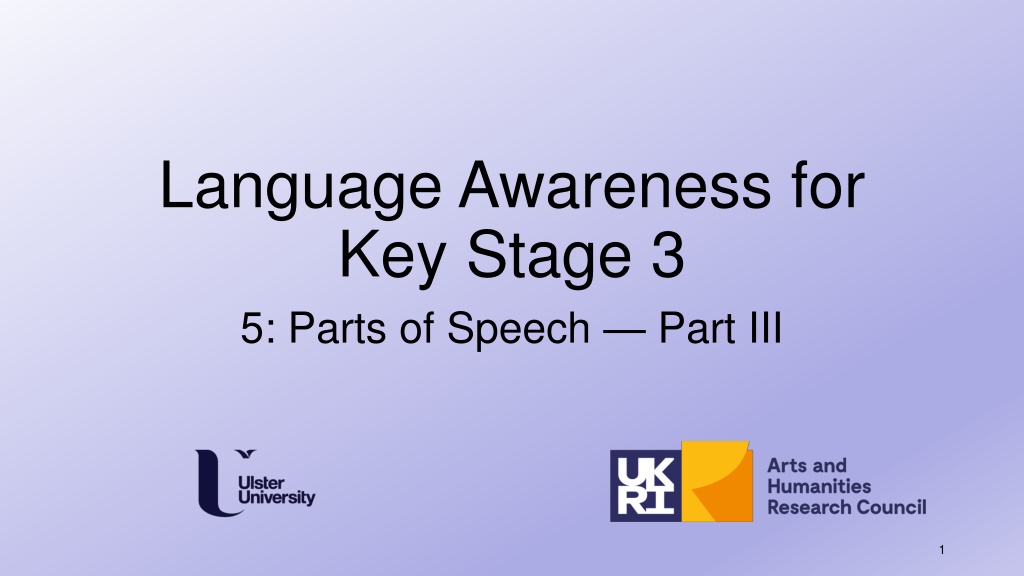





![Prevention and Combating of Hate Crimes and Hate Speech Bill [B.9B.2018]](/thumb/60513/prevention-and-combating-of-hate-crimes-and-hate-speech-bill-b-9b-2018.jpg)

